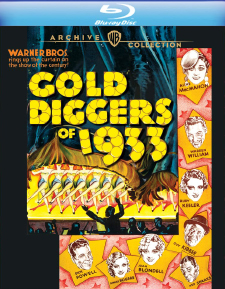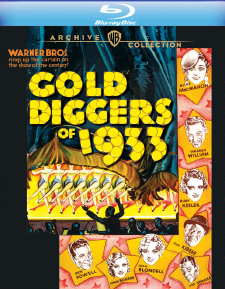Gold Diggers of 1933 (Blu-ray Review)

Director
Mervyn LeRoy, Busby BerkeleyRelease Date(s)
1933 (February 8, 2022)Studio(s)
Warner Bros (Warner Archive Collection)- Film/Program Grade: A+
- Video Grade: A
- Audio Grade: B
- Extras Grade: B-
Review
Mervyn Leroy’s Gold Diggers of 1933 opens with Ginger Rogers singing We’re in the Money in pig Latin, while wryly rolling her eyes at the camera, and it closes with an extraordinary paean to homeless WWI veterans, Remember My Forgotten Man. That’s a perfect summation of the film as a whole: a wondrous confection of catchy songs, imaginatively staged musical numbers, and witty dialogue, but one that never loses sight of the real struggles facing Americans during the Great Depression. It combines escapism with anti-escapism, and miraculously finds the perfect balance between the two.
That’s made abundantly clear during the opening number, where Busby Berkeley’s extravagant but facetious choreography for We’re in the Money visualizes the irony contained in those lyrics, just before harsh reality comes crashing in as the police show up to repossess everything, including the costumes—the show in which these chorus girls are performing can’t pay its bills, because it isn’t in the money. The rest of the story follows Joan Blondell, Aline MacMahon, Ruby Keeler, and Ginger Rogers as they try to find work any way that they can. That ultimately brings them back to their old producer (Ned Sparks) as he tries to put together a new show. Keeler offers the services of her neighbor (Dick Powell), a talented but unknown songwriter, and that leads to a series of complicated romantic and financial entanglements involving Powell, Warren William, and Guy Kibbee.
Gold Diggers of 1933 was written by Erwin Gelsey and James Seymour, with dialogue by David Boehm and Ben Marks, loosely based on the 1919 play The Gold Diggers by Avery Hopwood. That play had already been adapted twice previously, the first time as a silent film in 1923, and the second time as the early musical Gold Diggers of Broadway in 1929. (Both films are considered lost, with only a few extant reels available for either of them.) While the Production Code had already been instituted at that point, it wouldn’t be enforced until Joseph Breen was appointed head of the PCA in 1934, and the script for Gold Diggers of 1933 took advantage of those laxly enforced standards at every opportunity:
“Aw, gee. I look much better in clothes than any of you. If Barney could see me in clothes...”
“He wouldn't recognize you.”
The songs from Harry Warren and Al Dubin also push the edge of the envelope, especially in the cheeky way that they’re staged by Busby Berkeley. That’s nowhere more evident than in the truly eye-opening number Pettin’ in the Park, which is a thinly-veiled ode to the joys of sex. Berkeley’s choreography features barely disguised nudity, and it also includes moderately disturbing antics from a nine-year-old Billy Barty, who plays the toddler happily fueling some of the shenanigans.
The majority of the plot in Gold Diggers of 1933 isn’t particularly consequential, with its romantic twists and turns played as farce, but there’s an edge to the proceedings because of the ever-present threat of financial insecurity due to the Depression. Rather audaciously for an escapist musical, Warner Bros decided to end the film on a downbeat recognition of that reality. The main storyline offers a fairy tale happy ending for most of its protagonists (although Rogers is left out in the cold), but that’s followed immediately by the closing number Remember My Forgotten Man. It’s one of the most unforgettable endings of any musical from any era. Berkeley’s choreography is suitably grim, and the song is hauntingly performed by the great Etta Moten and Joan Blondell (Moten actually dubbed Blondell’s singing voice, but Blondell still sells the emotion of the moment). It’s a potent scene that resonates to this very day:
“Remember my forgotten man
You put a rifle in his hand
You sent him far away
You shouted: ‘Hip-hooray!’
But look at him today.”
Cinematographer Sol Polito shot Gold Diggers of 1933 on 35 mm film using spherical lenses, framed at 1.37:1 for its theatrical release. The transfer on Warner Archive’s Blu-ray version is derived from a scan of a fine grain master, and it’s a sight to behold. Everything looks pristine, with no significant damage to report, and perfectly resolved grain. Dupe footage from optical transitions is naturally softer, with coarser grain, but the good news is that they’re cut into the middle of the shots, so they don’t affect the surrounding material. There are just a few other bits of unexplained dupe footage here and there, such as the shot at 51:48, but they’re barely noticeable. The grayscale, contrast, and black levels are nearly flawless. The shot dollying into a close-up of Rogers while she sings in pig Latin goes in and out of focus, but it’s always been that way—the focus puller on set apparently struggled to keep up with the camera move. Yet once it finally locks onto her face, what a close-up! It’s a gorgeous example of the detail and precision that this transfer can offer—as per usual, Warner Archive is on the money.
Audio is offered in English 2.0 mono DTS-HD Master Audio, with optional English subtitles. There’s persistent background noise throughout the film, and the fidelity is naturally limited, but it’s an otherwise solid presentation of this kind of vintage soundtrack. The dialogue understandably can sound a bit thin, but it’s clear enough that Aline MacMahon’s zingers shine through. (It’s also clear enough to make out the unknown chorus girl saying, “Shit! I can’t find my shoe!” just before the Shadow Waltz number.)
The following extras are included:
- FDR's New Deal... Broadway Bound (SD – 15:36)
- Warner Bros. Cartoons: We're in the Money (HD – 6:46)
- Warner Bros. Cartoons: Pettin' in the Park (HD – 7:00)
- Warner Bros. Cartoons: I've Got to Sing a Torch Song (HD – 6:43)
- Warner Bros. Shorts: Rambling 'Round Radio Row (SD – 9:11)
- Warner Bros. Shorts: 42nd Street Special (SD – 5:45)
- Warner Bros. Shorts: Seasoned Greetings (SD – 19:47)
- Theatrical Trailer (HD – 2:41)
The extras are ported over from Warner Archive’s 2006 DVD release, minus the 42nd Street: from Book to Stage to Screen featurette, which wasn’t relevant to Gold Diggers of 1933 anyway. (The trailers for other films have also been omitted.) FDR’s New Deal explains how the brothers Warner were ardent supporters of Roosevelt, and they felt that he had the best chance of lifting the country out of the Great Depression. It also looks at the development of Gold Diggers of 1933, the way that studios like Warner Bros deliberately ignored the production code, and the significance of the Forgotten Man sequence. It includes interviews with a wide variety of historians, choreographers, and admirers, including Rick Jewell, John Kendrick, Martin Rubin, John Waters, and John Landis. The Warner Bros. Cartoons are a real treat, as they aren’t in common circulation with the other Merry Melodies and Looney Tunes cartoons. That’s because they’re essentially promotional shorts, intended to sell the music from the film in a slightly more family-friendly fashion. (At least by the standards of the time, that is; they still include racially insensitive material.) The good news is that they’ve all been upgraded to full HD, and are much improved from previous versions. Warner Bros. Shorts are a collection of vintage pre-show short subjects from the era, with the 42nd Street Special being more of a staged newsreel promoting that film, and the other two offering thinly-veiled narratives to hold together musical numbers and other bits. Watch Seasoned Greetings in particular for an early appearance by Sammy Davis, Jr., who’s instantly recognizable despite being only 7 years old!
The Depression-era trappings in Gold Diggers of 1933 may not be relevant to modern audiences, but the socially conscious messaging still is, and the joyous escapism that the film offers will never go out of style. Gold Diggers of 1933 is just that: pure cinematic gold. This Warner Archive Blu-ray belongs in the collection of every serious film fan—actually, it belongs in every single collection, full stop. If you aren’t already a serious film fan, Gold Diggers of 1933 will turn you into one. It’s the gift that keeps on giving.
- Stephen Bjork
(You can follow Stephen on social media at these links: Twitter and Facebook.)

